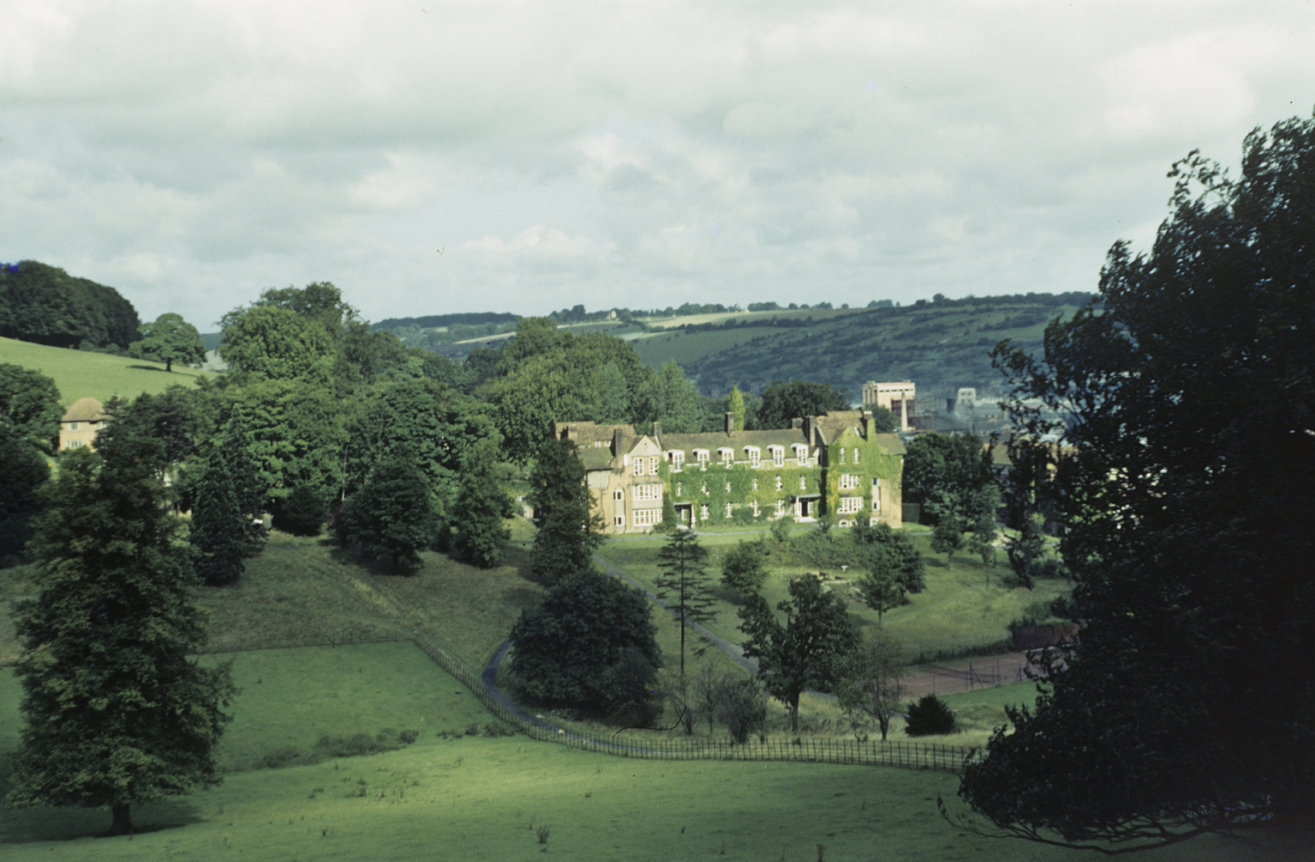High Wycombe
Military site
IWM, Roger Freeman Collection
Object Number - FRE 7529 - 8th Air Force accomodation at Daws Hill House. Image via JR Johnson. Written on slide casing: 'Daws Hill House.'
High Wycome known as Daws Hill was the Headquarters of Eighth Air Force Bomber Command (Pinetree). Situated on land and in a house formerly occupied by Wycombe Abbey School and restored to them by the US on 9 May 1946.
It incorporated the facility known as Camp Lynn (named in honour of Second Lieutenant William G Lynn Jnr who failed to return from a raid on the Netherlands on 4 July 1942) and Daws Hill. An underground bunker was dug underneath Roundabout Hill (below Daws Hill), and a large encampment of tents and huts was constructed within the Abbey parkland and to the east and south of Daws Hill House to accommodate staff associated with the HQ. The encampment was sold to the Ministry of Defence in 1946, and from 1958-1965 part of the US Strategic Air Command was based there. Due to its role during the cold war a peace camp was organised there from 1982 to at least 1984. The US Navy used it for US Visiting Forces in the early 2000s, and in 2007 the site passed to RAF. It has since been redeveloped.
Connections
See how this entry relates to other items in the archive by exploring the connections below.
Detailed History
On the first floor the large, vaulted and marble-floored lobby remained unchanged, except for a reception desk. A corridor to the left led first to the Commanding General's suite, which was once the head mistress's office, adjoining an office for his aide and secretary. Next was a large room ideal for operations and beyond that an even larger room that became the war room where Eaker, his staff and a steady parade of VIP visitors were briefed daily on the war news.
The Air Force Engineer moved into Campbell House. The Public Relations officer moved into Airlie House. The Air Force Surgeon moved into Barry House.
English Heritage's Record Description
RAF Daws Hill was established in 1942 when the Air Ministry requisitioned Wycombe Abbey School and its lands. The site originally consisted of a large underground bunker and a hutted encampment to the south and east of Daws Hill and on parkland near to the Abbey. It was used as a headquarters by the United States 8th Air Force until the end of the war. In 1946 the Abbey building was returned to the school, however, the land occupied by the camp and the bunker was sold to the Ministry of Defence.
In the 1950s, RAF Daws Hill, also known as High Wycombe Air Station, was used again as a base by US forces during the Cold War. Between 1958 and 1965 it was the headquarters of the 7th Air Division USAF in the UK, part of US Strategic Air Command. It continued to have an active role during the Cold War and its facilities included a nuclear bunker. At the end of the Cold War its use reduced, however, around the year 2000, the site was developed by the US Navy for use by the United States Visiting Forces (USVF) and became known as USVF Daws Hill. This site includes two housing areas (Service Family Accommodation) - the Doolittle Estate and Eaker Estate (named after General Ira Clarence Eaker, commander of the US Eighth Air Force during the Second World War) and a technical area with workshops, a bowling alley, school, tennis courts and dormitory buildings. The base was also home, between 1971 and 2007, to the London Central Elementary High School - a United States Department of Defence Dependents School. In the 1980s a Peace Camp was also established at Dawes Hill.
In 2007 the US left RAF Daws Hill and it passed into the hands of the RAF and continued to be used as Service Family Accommodation. In 2011 an announcement was made by the Ministry of Defence that the site was to be disposed of.
People

- Military/Civilian/Mascot: Military
- Nationality: American
- Unit: US Strategic Air Forces VIII Bomber Command 95th Bomb Group 412th Bomb Squadron
- Service Numbers: O-17175
- Highest Rank: General
- Role/Job: Commanding General

- Military/Civilian/Mascot: Military
- Nationality: American
- Unit: Eighth Air Force
- Role/Job: Doctor
- Military/Civilian/Mascot: Military
- Nationality: American
- Unit: Headquarters (Eighth Air Force)
- Service Numbers: A-500841

- Military/Civilian/Mascot: Military
- Nationality: American
- Unit: 381st Bomb Group 482nd Bomb Group 813th Bomb Squadron
- Service Numbers: O-803166
- Highest Rank: Captain
- Role/Job: Pilot
- Military/Civilian/Mascot: Military
- Nationality: American
- Unit: Headquarters (Eighth Air Force)
- Highest Rank: Sergeant
- Role/Job: Bombardier
Aircraft

- Aircraft Type: B-17 Flying Fortress
- Nicknames: The Bad Penny
- Unit: 403rd Air Depot 91st Bomb Group 322nd Bomb Squadron 324th Bomb Squadron Headquarters Squadron (8th Air Force)
- Aircraft Type: Tiger Moth
- Unit: 303rd Bomb Group 427th Bomb Squadron
- Aircraft Type: Lysander
- Unit: Headquarters Squadron (8th Air Force) Headquarters (Eighth Air Force)
Revisions
Barry Anderson, Army Air Forces Stations (Alabama, 1985) / http://www.adoptiegraven-database.nl/index.php/home
http://www.pastscape.org.uk/hob.aspx?hob_id=1549728#aRt
http://www.wycombeabbey.com/history/index.php
http://www.strategic-air-command.com/command/air_divisions/0007th_air_d…
Office of History, Headquarters Third Air Force, United States Air Forces in Europe; Installations and USAAF Combat Units in the United Kingdom 1942-1945, Revised and











